PRINCETON, NJ -- Despite extensive news coverage of what was widely portrayed as a disappointing government jobs report last Friday, Americans are about as likely to describe it as "mixed" (40%) as to say it is "negative" (42%), with a small minority characterizing it as "positive" (9%). But Americans who view the report as negative are more likely to say it was somewhat negative rather than very negative.
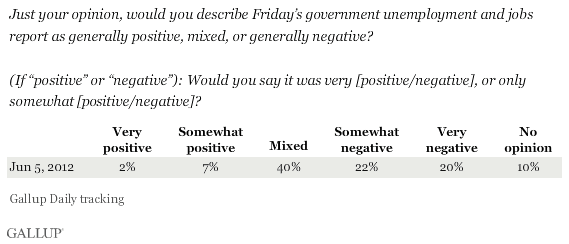
The government reported that 69,000 new jobs were created in May, the lowest amount so far this year, and that the overall unemployment rate rose from 8.1% in April to 8.2% in May. Most news accounts of the report portrayed it in a negative light. The Dow Jones Industrial Average fell by more than 270 points in Friday's trading after the report was released, and there was widespread discussion of a "stalled" economy and of the potentially deleterious impact of the report on President Obama's re-election chances. As NPR host Robert Siegel said on "All Things Considered" Friday afternoon: "It was the worst day of the year on the stock market. The Dow fell 274 points, putting the index back into negative territory for the year. The big reason? The latest monthly jobs report came in far weaker than expected. In May, the economy added just 69,000 new jobs."
The government itself was neutral in the press release accompanying the report: "Nonfarm payroll employment changed little in May (+69,000), and the unemployment rate was essentially unchanged at 8.2%, the U.S. Bureau of Labor Statistics reported today," although many observers may have seen the lack of change as a negative.
Those Following Jobs Report Closely Are Most Negative
Fifty-five percent of Americans said they were closely following the news about the "government's unemployment and jobs report that was released last Friday."
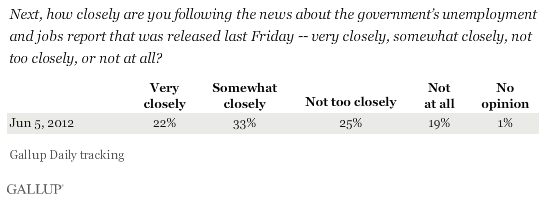
The average "closely followed" percentage for more than 200 news stories Gallup has tracked over the last 21 years is 60%, putting the news impact of Friday's jobs report somewhat below average. Still, more Americans reported paying attention to the jobs report than to the European financial crisis, as measured in a separate Gallup poll last week.
Those following the news closely were significantly more likely to describe the jobs report on the "negative" end of the scale than were those not following it closely. About two in 10 Americans who were not closely following the news said they didn't have an opinion of the report, but of those who did, more described it as mixed than as negative.
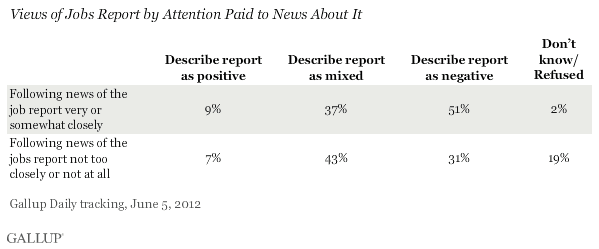
Republicans Describe Report More Negatively
Republicans were significantly more likely than independents or, particularly, Democrats to describe the jobs report as negative. Democrats were most inclined to describe it as mixed.
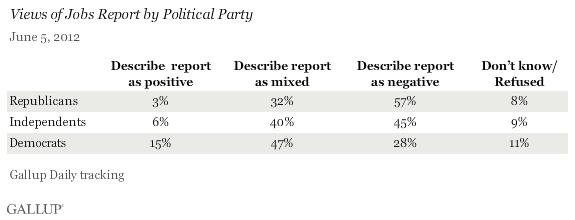
These data may reflect that more Republicans were paying very close attention to news of the report. But it also may be due to Republicans' higher negativity than Democrats' about the economy, a phenomenon that reflects partisans' relationship to the occupant of the White House.
No Change in Americans' Views of Economy Since Report
Despite Friday's jobs data, ongoing Gallup Daily tracking data continue to show little to no change in Americans' views of the overall economy since the report was released.
Americans' ratings of the current economy are essentially the same in the five days since the report as they were in the five previous days of interviewing, with an insignificant three-point increase in the percentage rating the economy as "poor." There has been no change at all in Americans' perceptions of whether the U.S. economy is getting better or getting worse.
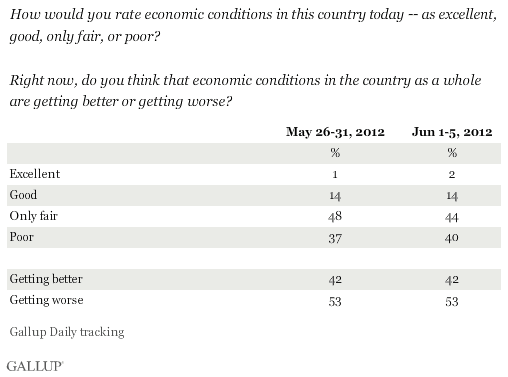
Bottom Line
There is little evidence that last Friday's government jobs report has had a negative impact on the way Americans view the U.S. economy. The number of Americans who closely followed news about the report is slightly below average compared with other news stories Gallup has measured, and descriptions of the report are as likely to be "mixed" as they are to be "negative."
Republicans had the most downbeat views of the report, with well over half saying it was negative. This may reflect the already-existing tendency for Republicans to be negative about the economy, particularly in an election year in which the main focus of the Republican presidential candidate is that the economy has not done well under the stewardship of a Democratic president.
All in all, these data suggest that the average American apparently had less of a sharply negative reaction to the jobs report than might have been anticipated by a review of either the stock market reaction, or the way in which the news media portrayed Friday's jobs report.
Gallup.com reports results from these indexes in daily, weekly, and monthly averages and in Gallup.com stories. Complete trend data are always available to view and export in the following charts:
Daily: Employment, Economic Confidence, Job Creation, Consumer Spending
Weekly: Employment, Economic Confidence, Job Creation, Consumer Spending
Read more about Gallup's economic measures.
View our economic release schedule.
Survey Methods
Results for this Gallup poll are based on telephone interviews conducted June 5, 2012,on the Gallup Daily tracking survey, with a random sample of 1,007 adults, aged 18 and older, living in all 50 U.S. states and the District of Columbia.
For results based on the total sample of national adults, one can say with 95% confidence that the maximum margin of sampling error is ±4 percentage points.
Interviews are conducted with respondents on landline telephones and cellular phones, with interviews conducted in Spanish for respondents who are primarily Spanish-speaking. Each sample includes a minimum quota of 400 cell phone respondents and 600 landline respondents per 1,000 national adults, with additional minimum quotas among landline respondents by region. Landline telephone numbers are chosen at random among listed telephone numbers. Cell phone numbers are selected using random-digit-dial methods. Landline respondents are chosen at random within each household on the basis of which member had the most recent birthday.
Samples are weighted by gender, age, race, Hispanic ethnicity, education, region, adults in the household, and phone status (cell phone only/landline only/both, cell phone mostly, and having an unlisted landline number). Demographic weighting targets are based on the March 2011 Current Population Survey figures for the aged 18 and older non-institutionalized population living in U.S. telephone households. All reported margins of sampling error include the computed design effects for weighting and sample design.
In addition to sampling error, question wording and practical difficulties in conducting surveys can introduce error or bias into the findings of public opinion polls.
Polls conducted entirely in one day, such as this one, are subject to additional error or bias not found in polls conducted over several days.
For more details on Gallup's polling methodology, visit www.gallup.com.
